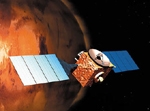 -with contributions from 15 nations, Mars Express looks for traces of life
-with contributions from 15 nations, Mars Express looks for traces of life
On June 2, the European Mars Express spacecraft was launched on top of a Soyuz rocket from Baikonur, Kazakhstan, setting out for the planet Mars which will be reached in December 2003.
To power the mission, Kongsberg has delivered the mechanisms angling the two solar panels towards the sun.
The Mars Express orbiter spacecraft and its small companion, the "Beagle" Mars lander, both carry several advanced scientific instruments devised for the search of traces of life on the Red Planet. All results will be radio relayed back to Earth.
As a keen participant in European space research through cooperation in ESA, Kongsberg has designed, assembled and qualified the two SADM (for Solar Array Drive Mechanism) units which continuously adjust the angles of the solar panels to catch the maximum power from the sun during the flight to Mars and while orbiting the planet.
Kongsberg has delivered similar mechanisms to the Rosetta spacecraft (destined for a rendezvous with the comet Churyumov-Gerasimenko) and is also preparing SADMs for the Venus Express spacecraft.
When arriving Mars in December, the Mars Express orbiter will eject the Beagle2 before entering its final orbit.In orbit, the spacecraft will photograph the Mars landscape using a powerful high-resolution camera.The Beagle2 will land on the Mars surface in an equatorial region. It will dig out samples from the ground, analyse them and send the results to Mars Express from where they will be sent back to Earth.Links: www.esa.int/export/SPECIALS/Mars_Express